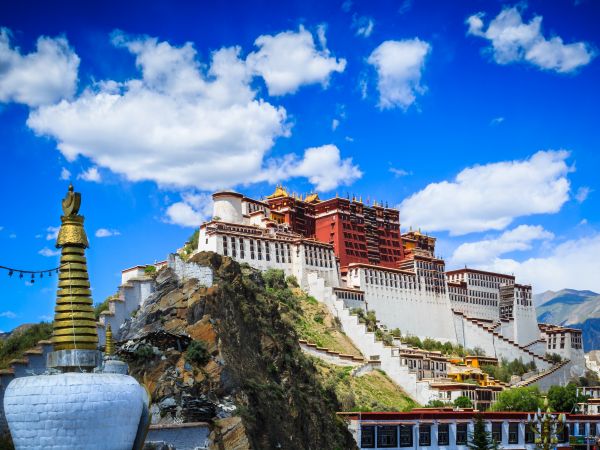Potala Palace
"Potala" is a transliteration of Sanskrit meaning the abode of Avalokitesvara Bodhisattva. The Potala Palace is located on Marpo Ri Mountain northwest of Lhasa city center and is a symbol of Lhasa and the Tibetan Plateau. With a total area of about 360,000 square meters and a height of more than 200 meters, it has 13 floors in appearance, but in reality it is only 9. It stands on the red mountain and was the palace of ancient Tibetan kings and the Dalai Lamas, as well as the center of the religious and political government of the local rulers of Tibet in the past.

1.History of construction:
This palace, the highest and most majestic in the world in altitude, houses a unique cultural heritage of Tibet. The Potala Palace is divided into three parts: the Snow City, the White Palace and the Red Palace, and its construction history spans more than a thousand years.
641 AD: King Songtsen Gampo of the Tubo Kingdom began construction of the Potala Palace.
9th century: The Kingdom of Tubo disintegrated and the Potala Palace was almost completely destroyed.
1642: The fifth Dalai Lama became the unified political and religious leader of Tibet and rebuilt the Potala Palace.
1690: King Tsenzhab Sangye Gyatso began the largest expansion in history, significantly expanding the White Palace while the Red Palace was being built, as well as adding courtyards and passageways around the two palaces. It was completed in 1693.
1922: The 13th Dalai Lama restored the White Palace and added two more floors to the Red Palace. Until 1936, when the Stupa Temple of the 13th Dalai Lama was completed, the Potala Palace has remained unchanged since then.
1994: The Potala Palace was included in the UNESCO World Heritage List.

2.Main buildings:
White Palace:
The White Palace is the white part of the entire building and used to be the residence of the Dalai Lama and the seat of Tibet's local government, the Kashag. From the base of the mountain to the top, the eastern entrance is decorated with numerous magnificent wall paintings, such as that of the Four Heavenly Kings, who are the protectors in Buddhism.
After passing through a square, which used to be the place where Tibetan opera performances were held for the Dalai Lama, you reach the "Hall of East and West", where the sun shines all day. This is the bedroom of the Dalai Lama and the place where political affairs were carried out. The hall includes a worship room, a study room, a sacred text study room and a bedroom, all lavishly decorated. On the fourth floor is the largest East Hall of the White Palace, with an area of 700 square meters, where important events such as the Dalai Lama's enthronement ceremony were held, but now it is not open to the public.

Red Palace:
The Red Palace is located in the center and at the highest point of the Potala Palace, with red outer walls. The main building of the Red Palace is where the stupas of the Dalai Lamas of past generations are stored. Since the fifth Dalai Lama occupied the Potala Palace, there have been nine deceased Dalai Lamas, but there are only eight stupas, as that of the sixth Dalai Lama, Tsangyang Gyatso, is missing.
Each stupa has a similar shape but different sizes. The largest is that of the fifth Dalai Lama, which measures 12 meters high and has three levels with 16 columns inside. It is covered in gold, with 4 tons of gold used, and encrusted with countless precious gems, of incalculable value. In the Stupa Temple of the 11th Dalai Lama, the silver statue of the 5th Dalai Lama is the same size as the golden statue of Shakyamuni, a rare work of art that represents the outstanding position and achievements of the 5th Dalai Lama in Tibet.
The Red Palace houses numerous treasures, and the Hall of Three Jewels used to hold the divination ceremony with golden bottles. There is a congratulatory board awarded by Emperor Daoguang of the Qing Dynasty hanging above the lintel of the Avalokiteshvara Hall, and in the hall is a statue of Avalokiteshvara naturally formed from a sandalwood tree, a supreme treasure of the Potala Palace.

The West Great Hall is the largest hall in the Red Palace, and the wall paintings surrounding it depict the fifth Dalai Lama's visit to Beijing to meet Emperor Shunzhi and his appointment as the Dalai Lama. The "Initial Lotus Fountain" board is a calligraphic work of the Qianlong Emperor.
3.About Songtsen Gampo and Princess Wencheng
Songtsen Gampo:
Songtsen Gampo is the most important and well-known Tibetan king in the history of Tibet. He achieved the unification of the Tibetan plateau and formally established the Tubo dynasty.

He was born in 617 and built the Potala Palace for his wife, Princess Wencheng. Most of this palace, built in the 7th century, was destroyed in a fire, except for the Damo Cave and the Temple of Saints, which are the only ancient remains found north of the Red Palace. Damo Cave is said to have been the place where Songtsen Gampo meditated in silence and where statues of Songtsen Gampo, Princess Wencheng and her ministers are venerated. The Temple of Saints houses some important statues of Buddha and the main images of the seventh, eighth and ninth Dalai Lamas.
Songtsen Gampo has been highly respected by Tibetans, not only is he considered the incarnation of Avalokitesvara, but he is also one of the three great kings of legend.
Princess Wencheng:
In 641, King Tubo Songtsen Gampo sought an alliance with the Tang Dynasty (618-907) to repair relations and requested a marriage. Emperor Taizong of the Tang Dynasty married Princess Wencheng to Songtsen Gampo. Princess Wencheng was highly respected in Tibet and it is said that she was the one who introduced Buddhism to Tibet. Furthermore, Princess Wencheng participated in the construction of many temples in Tibet.

Although with the development of the times, the city of Lhasa has been growing in concentric circles, the Potala Palace, the jewel at the top of the world, remains the unchanged center of the city. Every day, from the first ray of sunlight that illuminates it until the end of the day, countless pilgrims surround it incessantly, reciting prayers and prostrating themselves, keeping their inner faith firm.

















